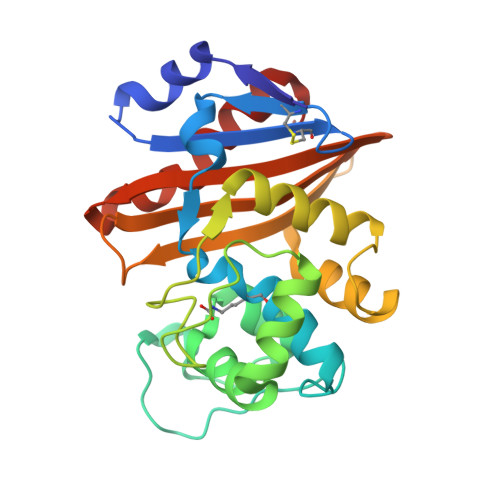Evolution to carbapenem-hydrolyzing activity in noncarbapenemase class D {beta}-lactamase OXA-10 by rational protein design.
De Luca, F., Benvenuti, M., Carboni, F., Pozzi, C., Rossolini, G.M., Mangani, S., Docquier, J.D.(2011) Proc Natl Acad Sci U S A 108: 18424-18429
- PubMed: 22042844
- DOI: https://doi.org/10.1073/pnas.1110530108
- Primary Citation of Related Structures:
3QNB, 3QNC - PubMed Abstract:
Class D ¶¬-lactamases with carbapenemase activity are emerging as carbapenem-resistance determinants in gram-negative bacterial pathogens, mostly Acinetobacter baumannii and Klebsiella pneumoniae. Carbapenemase activity is an unusual feature among class D ¶¬-lactamases, and the structural elements responsible for this activity remain unclear. Based on structural and molecular dynamics data, we previously hypothesized a potential role of the residues located in the short-loop connecting strands ¶¬5 and ¶¬6 (the ¶¬5-¶¬6 loop) in conferring the carbapenemase activity of the OXA-48 enzyme. In this work, the narrow-spectrum OXA-10 class D ¶¬-lactamase, which is unable to hydrolyze carbapenems, was used as a model to investigate the possibility of evolving carbapenemase activity by replacement of the ¶¬5-¶¬6 loop with those present in three different lineages of class D carbapenemases (OXA-23, OXA-24, and OXA-48). Biological assays and kinetic measurements showed that all three OXA-10-derived hybrids acquired significant carbapenemase activity. Structural analysis of the OXA-10loop24 and OXA-10loop48 hybrids revealed no significant changes in the molecular fold of the enzyme, except for the orientation of the substituted ¶¬5-¶¬6 loops, which was reminiscent of that found in their parental enzymes. These results demonstrate the crucial role of the ¶¬5-¶¬6 loop in the carbapenemase activity of class D ¶¬-lactamases, and provide previously unexplored insights into the mechanism by which these enzymes can evolve carbapenemase activity.
Organizational Affiliation:
Dipartimento di Biotecnologie, Laboratorio di Fisiologia e Biotecnologia dei Microrganismi, Universit®§ di Siena, I-53100 Siena, Italy.



















